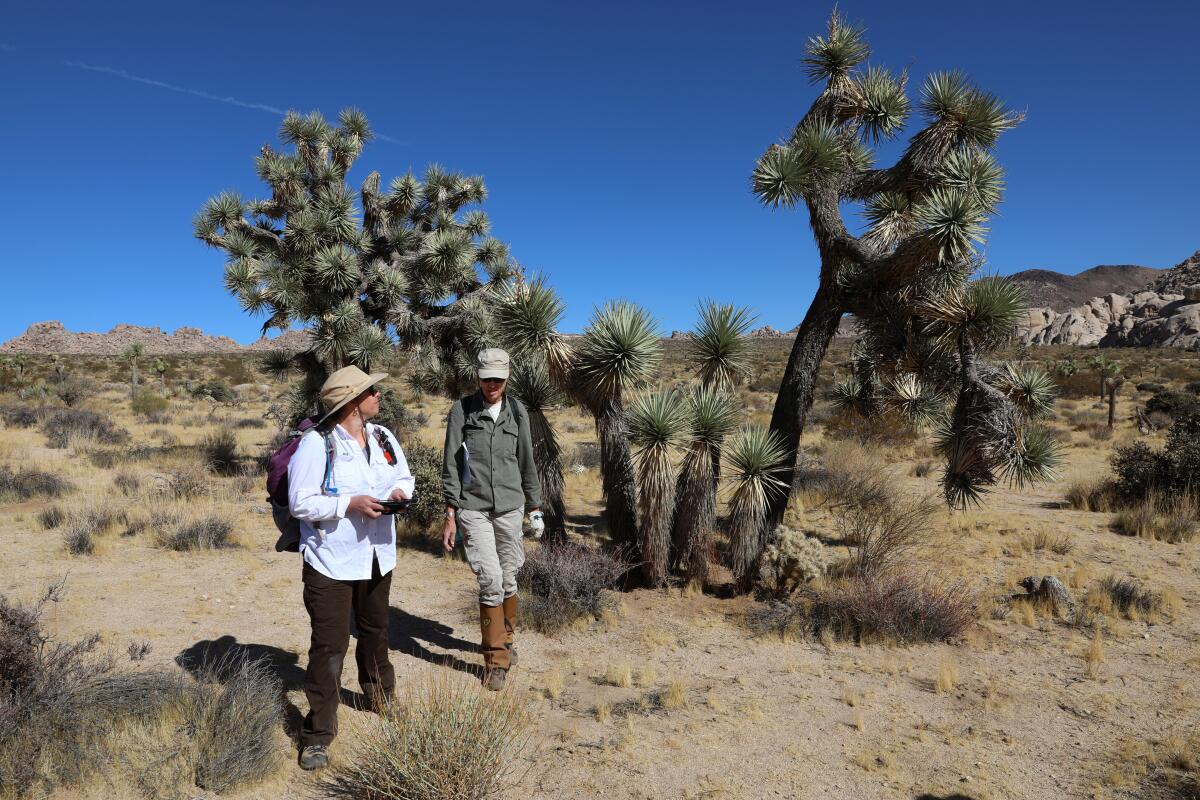Climate change is killing California’s iconic trees

- Share via
Firefighters and forest ecologists are again scrambling to save ancient giant sequoia trees from the threat posed by increasingly fast, powerful and destructive wildfires that have raged through California in recent years.
This time the fire is in Yosemite National Park. Crews have laid sprinkler systems to protect Mariposa Grove — home to the 2,000- to 3,000-year-old Grizzly Giant and some 500 other mature sequoias — from the oncoming Washburn fire.
Sequoias, with their thick bark and branches high above the ground, have adapted to living with fire and even rely on low- to moderate-intensity heat from wildfires to reproduce. But they are less able to withstand the intense blazes that are regularly burning through California, fueled by decades of fire suppression and climate change.
As fire rages toward groves of historic sequoia trees, sometimes you have to rely on something as low tech as tin foil to help save them.
Conservationists told Times reporters Alex Wigglesworth and Diana Marcum that we’ve lost about 20% of the giant sequoia population over the last six years — a pace that does not bode well for the species’ long-term survival. The trees grow naturally only in California, on the western slope of the Sierra Nevada.
It’s terrible to contemplate the destruction that’s happening. Giant sequoias have lived and adapted to environmental conditions for centuries, yet in mere decades, humans have managed to make their ecosystem less hospitable and the planet downright dangerous for their survival.
And giant sequoias are not the only iconic trees facing a threat.

A recent study led by U.S. Forest Service biologists found pockets of Great Basin bristlecone pine in California and Utah that were unexpectedly dying off. The bristlecone pine is found in high-elevation areas and is revered for its extreme longevity, with some more than 4,000 years old.
Warmer temperatures and drought have put stress on the trees and made them vulnerable to bark beetles. Biologists found hundreds of dead bristlecone pines on Telescope Peak in Death Valley. So far, Methuselah, a 4,853-year-old bristlecone pine that may be the oldest living tree on Earth, has remained free of bark beetles, Times reporter Louis Sahagun wrote last month.
State scientists have recommended against listing Joshua trees as a threatened species. But they are imperiled by climate change and need protections.
Meanwhile, the California Fish and Game Commission is deciding whether the western Joshua tree, which faces an existential threat from climate change, should be listed under the California Endangered Species Act.
Scientists predict that the trees, which can live for about 200 years, could lose upward of 90% of their current habitat in the Mojave Desert by the end of the century. Hotter, drier conditions from climate change, along with wildfire and development, are expected to cause the trees to die off at an increasing pace. Joshua Tree National Park could lose most of its namesake trees.

But California Department of Fish and Wildlife staff recommended in April that the western Joshua tree not be listed as threatened, saying it is not in serious danger of extinction in the foreseeable future. Denying protection would be a grave mistake and would make it harder to save the trees later.
How many more warnings do we need to act? Climate change is threatening some of our iconic trees that have stood for centuries, even millennia.
We need to be far more urgent, creative and committed in trying to keep these trees and their ecosystems healthy. This means ensuring that at-risk species are protected from the immediate harms of wildfire, bark beetles, development and other threats. It also means ending dependence on fossil fuels and slashing greenhouse gas emissions to slow global warming, which is the larger threat we all face.
More to Read
Toward a more sustainable California
Get Boiling Point, our newsletter exploring climate change, energy and the environment, and become part of the conversation — and the solution.
You may occasionally receive promotional content from the Los Angeles Times.











